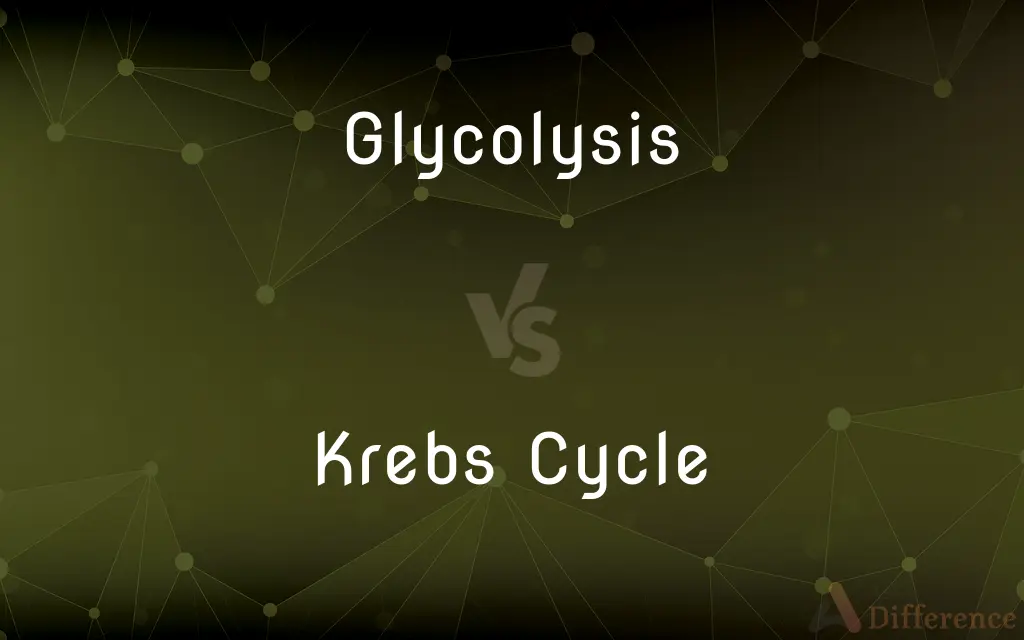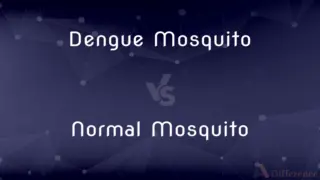Glycolysis vs. Krebs Cycle — What's the Difference?
Edited by Tayyaba Rehman — By Fiza Rafique — Published on January 5, 2024
Glycolysis breaks down glucose for ATP and pyruvate; Krebs Cycle processes pyruvate for more ATP and electron carriers.

Difference Between Glycolysis and Krebs Cycle
Table of Contents
ADVERTISEMENT
Key Differences
Glycolysis is the metabolic pathway that converts glucose into pyruvate, yielding small amounts of ATP and NADH. It occurs in the cytosol and is anaerobic, not requiring oxygen.
The Krebs Cycle, also known as the citric acid cycle, is a series of enzyme-catalyzed chemical reactions that produce ATP and electron carriers. It takes place in the mitochondria and requires oxygen indirectly.
Glycolysis is the first stage of cellular respiration and can function without oxygen, making it crucial for both aerobic and anaerobic respiration. It is a ten-step process and is the universal pathway for glucose catabolism.
The Krebs Cycle is the second stage of aerobic respiration, following glycolysis when oxygen is present. It fully oxidizes the products of glycolysis (pyruvate) to carbon dioxide, and it supplies the electron transport chain with high-energy electrons.
Both pathways are essential for energy production, but glycolysis can occur quickly to meet immediate energy demands, while the Krebs Cycle is part of a longer, more energy-efficient process that requires oxygen and produces more ATP per glucose molecule.
ADVERTISEMENT
Comparison Chart
Location in the cell
Occurs in the cytosol
Takes place in the mitochondrial matrix
Oxygen requirement
Anaerobic (does not require oxygen)
Aerobic (requires oxygen indirectly)
Substrates used
Starts with glucose
Uses pyruvate derived from glucose
Products formed
Produces pyruvate, ATP, and NADH
Generates CO2, ATP, NADH, and FADH2
Role in metabolism
First stage of cellular respiration
Central hub of metabolic processes
Compare with Definitions
Glycolysis
The breakdown of glucose to generate ATP anaerobically.
During the workout, her cells relied on glycolysis for immediate energy.
Krebs Cycle
The process of converting pyruvate into CO2, ATP, and electron carriers.
The Krebs Cycle operates when oxygen is available to the cell.
Glycolysis
A ten-step process converting glucose into pyruvate, yielding energy.
Glycolysis quickly provides energy to muscles during a sprint.
Krebs Cycle
An aerobic pathway producing high-energy electrons for the electron transport chain.
The Krebs Cycle provides the electrons necessary for ATP production in the mitochondria.
Glycolysis
An energy-yielding process converting one glucose to two pyruvate molecules.
Glycolysis is the initial stage of cellular respiration in both aerobic and anaerobic conditions.
Krebs Cycle
A sequence of enzymatic reactions in mitochondria, central to energy production.
The Krebs Cycle is essential for the complete oxidation of metabolic fuels.
Glycolysis
The universal metabolic pathway for glucose catabolism.
Glycolysis is a process that happens in the cells of all living organisms.
Krebs Cycle
A cyclic metabolic pathway that oxidizes acetyl-CoA to produce ATP and CO2.
In the Krebs Cycle, the oxidation of fats and carbohydrates is linked to energy generation.
Glycolysis
A series of reactions producing energy from glucose without oxygen.
Yeast cells perform glycolysis to produce energy anaerobically.
Krebs Cycle
The second stage of cellular respiration that follows glycolysis.
Post-glycolysis, pyruvate enters the mitochondria to begin the Krebs Cycle.
Glycolysis
A metabolic process that occurs in nearly all living cells in which glucose is converted in a series of steps to pyruvic acid and during which energy is released in the form of ATP.
Glycolysis
(biochemistry) The cellular degradation of the simple sugar glucose to yield pyruvic acid, and ATP as an energy source
Glycolysis
A metabolic process that breaks down carbohydrates and sugars through a series of reactions to either pyruvic acid or lactic acid and release energy for the body in the form of ATP
Common Curiosities
What does glycolysis break down?
Glycolysis breaks down glucose into two molecules of pyruvate.
Can glycolysis happen without oxygen?
Yes, glycolysis can occur anaerobically without oxygen.
Where does the Krebs Cycle occur?
The Krebs Cycle occurs in the mitochondrial matrix.
How many ATP molecules does glycolysis produce?
Glycolysis produces a net gain of 2 ATP molecules per glucose.
Does glycolysis produce carbon dioxide?
No, glycolysis itself does not produce CO2; it is produced in the Krebs Cycle.
Is the Krebs Cycle part of aerobic or anaerobic respiration?
The Krebs Cycle is part of aerobic respiration.
What are the main products of the Krebs Cycle?
The Krebs Cycle produces ATP, NADH, FADH2, and CO2.
Are the ATPs produced in glycolysis and the Krebs Cycle the same?
The ATP molecules produced in both processes are chemically the same, but the Krebs Cycle is more indirectly involved in ATP synthesis.
How is the Krebs Cycle linked to the electron transport chain?
The Krebs Cycle generates electron carriers that feed into the electron transport chain for ATP production.
Does glycolysis occur in all cells?
Yes, glycolysis occurs in the cells of all living organisms.
What happens to pyruvate after glycolysis if oxygen is present?
Pyruvate enters the mitochondria and is used in the Krebs Cycle.
How many times does the Krebs Cycle turn for each glucose molecule?
The Krebs Cycle turns twice for each glucose molecule because glycolysis produces two pyruvates.
How does the Krebs Cycle affect muscle function?
The Krebs Cycle provides energy for sustained muscle activity through ATP.
Can the Krebs Cycle operate without glycolysis?
While the Krebs Cycle can use other substrates, it primarily operates on products of glycolysis.
What role does glycolysis play in fermentation?
In fermentation, glycolysis provides ATP and pyruvate, which is converted to lactate or ethanol.
Share Your Discovery

Previous Comparison
Equity vs. Shares
Next Comparison
Dengue Mosquito vs. Normal MosquitoAuthor Spotlight
Written by
Fiza RafiqueFiza Rafique is a skilled content writer at AskDifference.com, where she meticulously refines and enhances written pieces. Drawing from her vast editorial expertise, Fiza ensures clarity, accuracy, and precision in every article. Passionate about language, she continually seeks to elevate the quality of content for readers worldwide.
Edited by
Tayyaba RehmanTayyaba Rehman is a distinguished writer, currently serving as a primary contributor to askdifference.com. As a researcher in semantics and etymology, Tayyaba's passion for the complexity of languages and their distinctions has found a perfect home on the platform. Tayyaba delves into the intricacies of language, distinguishing between commonly confused words and phrases, thereby providing clarity for readers worldwide.













































